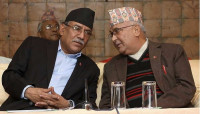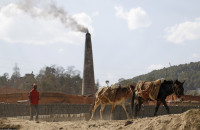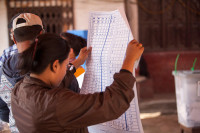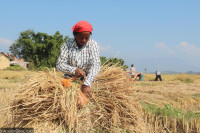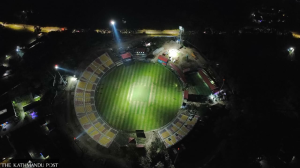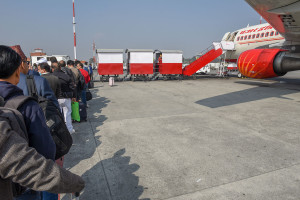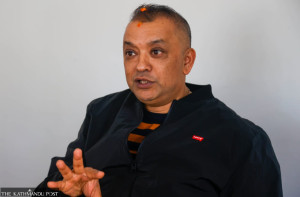Opinion
A middle way
Retention of current administrative territory in designing federal units could mean the preservation and extension of the domination of the high hill castes
Krishna Hachhethu
Owing to sharp polarisation on federal design, both at the social and political spheres—preference of Khas Arya and traditional political parties (ie, Nepali Congress and CPN-UML, in particular) for administrative federalism, and the aspiration of Madhesi, Janajati, and other new parties (Maoist and ethnic/regional parties) for identity-based federalism—the best way looks to be the middle path of identity-based non-ethnic federalism. This middle path seeks a balance—it respects the mandate of the second Consti-tuent Assembly (CA) elections and retains the spirit of movements for inclusive democracy.
The idea of a federal Nepal, as a byproduct of ethnic and regional movements and also the Maoist armed insurgency, was introduced with a desire for ethnic autonomy. So the consideration of ethnic contents in state-restructuring seeks a reversal in nation-building.
Historical baggage
The longstanding state designed national integration through assimilation into the fold of the Khas-Arya culture. This eventually translated social diversity into inequality among social groups (hill high castes as dominant and the rest, ie, Janajati, Madhesi and Dalit, as excluded) in all spheres, as indicated by the Human Development Index, Poverty Index and Governance Index. The very logic of making a federal Nepal is to achieve an inclusive polity which would consequentially provide an opportunity for the inclusion of those who have long been excluded from the power structure of the country.
Such a goal is admirable but the insertion of so many ethnic contents does not seem practical. The language used by the first champions of ethnic movements was problematic, as they propagated the notion of a federal Nepal that was hostile to Khas Arya sentiments. And in a way, as if federal Nepal would only serve the interests of excluded groups.
The reaction of the Brahmins/Chhetris to the Janajati and Madhesi movements has changed the public discourse on federal design. Portraying federalism with ethnic elements as an evil design that may potentially invite ethnic conflict and negatively affect national integration makes the issue even more complicated and conflicted. Nevertheless, encouraged by the result of the second CA elections in favour of the traditional parties, the NC and UML have strongly pushed for administrative federalism.
Illusive move
The historical cultural territory of social groups has not only been affected by internal migration but also dispersed politically since the introduction of 14 zones and 75 administrative districts in 1961, and in the 1970s through the addition of five development regions. The separation of cultural territory and administrative units has multiple political implications. The hill high castes, though they constitute only 30 percent of the country’s population, had 56-63 percent representation in previous parliaments. They constituted more than two-thirds among the presidents of the 75 District Development Committees.
So the retention of the current administrative territory in designing federal units could mean not only the preservation but also the extension of the hill caste domination to the entire political power structure of the country, including the provincial level of federal Nepal. Table 1 shows that the hill high castes constitute the majority or the largest group in six out of total seven provinces, as suggested by the NC. What could be its political implication? Table 2 shows that if the result of first-past-the-post system in the second CA election is taken as an indicator, it places the hill high castes in the position of a comfortable majority in five provinces and also close to the strength of Madhesis in another province.
So, the administrative model of federalism does not address the question as to why Nepal needs a federal setup. After all, federalism is a system that provides a middle political space in between central and local governments. If that political space is constructed in a way that facilitates the inclusion of excluded or minority groups in political power, it could result in true federalism as an instrument of the management of social diversity. So the reinvention of cultural territory as a political constituency is must.
10 provinces
The 10 provinces model (Table 3), which is based on the caste/ethnic demography, gives a sense of the potential fair distribution of political power among social groups at the provincial level.
The hill Brahmin/Chhetri groups constitute a sizeable majority in one province (Khaptad-Karnali) and are comfortably the largest group in one more province (Narayani). Similarly, Madhesis become the largest community in one province. Limbus, Rais, Tamangs, and Tharus become the largest group in their respective provinces. Newars, Gurungs, and Magars are numerically behind the largest group (hill Brahmin/Chhetri), but by a margin of only one percent in their respective provinces. Demographically speaking, Limbus would have greater political leverage in Limbuwan (as recommended by the State Restructuring Commission) than in Sagarmatha province (as proposed by the NC). This is true in the case of Rais, Tamangs, Newars, Gurungs, Magars, and Tharus.
So identity-based non-ethnic federalism entertains ethnicity at a limited level in naming and the territorial delineation of provinces, but it certainly rejects ethnicity as a constituency for political prime rights, first rights on natural resources, and preferential rights on provincial administrative.
Hachhethu is a professor of political science and author of a number of books on Nepal




 22.12°C Kathmandu
22.12°C Kathmandu

